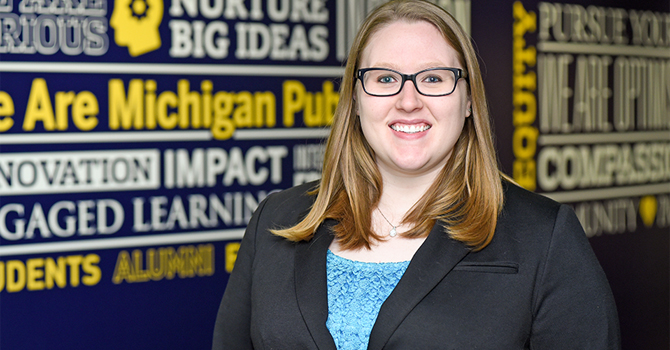Math and Other Risky Things

Lauren Beesley
PhD ’18, Biostatistics
To be honest, biostatistics was a huge risk. As a long-time mathematics student without much exposure to applied statistics, I was intrigued by the idea of using my math skills to serve what one might call a greater purpose. But planning a career in a field I was just beginning to understand was definitely a risk.
A summer biostatistics program during college got me interested enough to take on some projects in cancer research. I applied to Michigan because the Biostatistics Department is not only top-ranked and academically stimulating but also fosters a supportive, engaging, and inspiring environment for students.
That combination of expectation and support is huge, because in biostatistics the learning curve is significant. In theoretical math, you need to understand formulas and theorems. In biostatistics, you go way beyond the math. You have to understand the science well and you have to cultivate communication and collaboration skills. Building on my foundation in pure math has proven rewarding and eye-opening.
Biostatistics offers so many good career paths—in government, in pharmacy, in academia. Michigan's Training Program in Cancer Biostatistics put me to work immediately on several cancer-related problems, helping me see the impact of my work on real scientific problems. The program is managed by faculty advisors, who support us as we work with actual "clients" and gain professional experience.
Vital scientific questions are at the root of everything we do, and the math is part of our road to new solutions.
My initial understanding of cancer and cancer research was limited, but in working with oncologists and many others in cancer research, I've gained a facility with cancer research that informs my statistical modeling and keeps me excited about the work every day.
To outsiders, the technical side of biostatistics can make it seem siloed and inaccessible. But the field is actually highly interdisciplinary. Most students here collaborate on projects anchored in pressing, real-world health problems like cancer, mental health issues, and cardiovascular disease. Vital scientific questions are at the root of everything we do, and the math is part of our road to new solutions.
Biostatistics can remind us of the uncertainty of our conclusions, but it can also help us shore up what we know and give us confidence to move forward. A lot of failure goes into scientific work. For results-oriented people, that can be difficult.
But you learn to live with failure and even embrace it. Our solutions help keep people healthy and help those with problems get better. We collaborate with doctors for whom the results of our studies—even negative results—affect how they treat patients. Seeing direct benefits for someone's health and well-being helps counterweigh the frustrations of all the projects that might have "failed."
I have found some kindred spirits in the biostatistics community here at Michigan. Biostatistics often attracts people who want to make connections and want to serve that greater purpose.\
Our faculty help set that tone. They like each other as people and create an academic and social community for students to do the same.
Do we push ourselves? Yes. Do the faculty have huge expectations for us? Of course. But the faculty also foster a highly cooperative atmosphere, as opposed to the highly competitive atmosphere you might expect. We have positive and meaningful relationships with each other outside of the lab and classroom, and it can make all the difference. I don't think we could get through all the hard work without trusting and supporting each other.
You cannot know all that biostatistics has to offer until you start doing it. Your math skills will see you through, but you cannot fathom how interesting the work will be until you put that toe in the water.
The department's unique approach to student support might be an unusual vision for academia, but it was the right one for me. I want the incoming students to succeed here and to be the difference makers. Public health is a big, diverse field, but our biostatistics careers will keep us connected in the future. It is good to understand and care about those we will be working with well beyond our Michigan years.
You cannot know all that biostatistics has to offer until you start doing it. Your math skills will see you through, but you cannot fathom how interesting the work will be until you put that toe in the water. It is a creative setting for a mathematician. The risk was worth it.
This article first appeared in the spring 2018 issue of Findings, the magazine of the University of Michigan School of Public Health.
